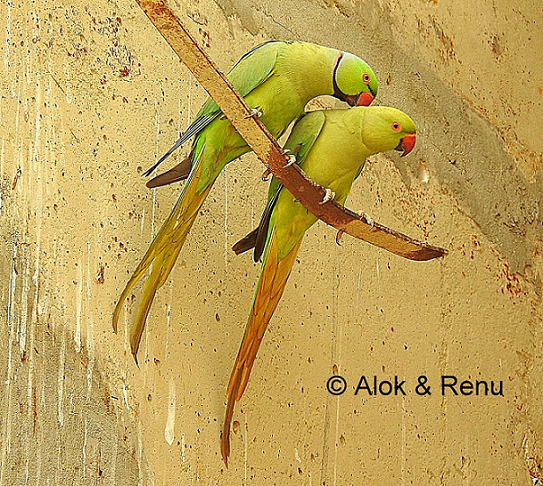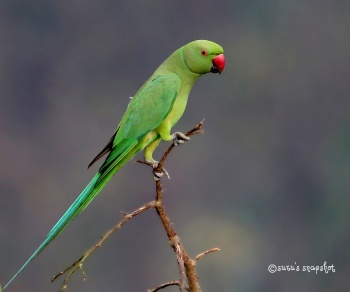(Video link) |
m (→External Links) |
||
| (20 intermediate revisions by 7 users not shown) | |||
| Line 1: | Line 1: | ||
| − | [[Image: | + | [[Image:rose-ringed_parakeet.png|thumb|550px|right|Courting Pair Subspecies ''P. k. borealis''<br />Photo © by {{user|aloktewari|Alok Tewari}}<br />Gurgaon Rural, Haryana, [[India]], May-2018]] |
'''Alternative Name: Ring-necked Parakeet''' | '''Alternative Name: Ring-necked Parakeet''' | ||
| + | |||
;[[:Category:Psittacula|Psittacula]] krameri | ;[[:Category:Psittacula|Psittacula]] krameri | ||
==Identification== | ==Identification== | ||
| − | + | [[Image:Psittacula krameri by surunair.jpg|thumb|350px|right|''Psittacula krameri manillensis'', female<br />Photo © by {{user|surunair|surunair}}<br />Mumbai, India; February 2013]] | |
| + | 37–43 cm (14½-17 in)<br /> | ||
*Green plumage | *Green plumage | ||
| − | * | + | *Long tail, with blue-green central feathers and yellower side feathers |
| + | *Red bill, often with black lower mandible | ||
'''Male'''<br /> | '''Male'''<br /> | ||
| − | *Black neck-ring | + | *Black neck-ring |
*Pink nape-band | *Pink nape-band | ||
| − | '''Female and immature''' both lack the neck rings, or show a shadow-like pale to dark grey neck-ring and a light nape-band<sup>[[#References|[ | + | *Full plumage acquired in third year. |
| + | '''Female and immature''' both lack the neck rings, or show a shadow-like pale to dark grey neck-ring and a light nape-band<sup>[[#References|[3]]]</sup>. | ||
==Distribution== | ==Distribution== | ||
| − | [[Africa]], [[Asia]] and [[ | + | Across northern sub-saharan [[Africa]] from [[Mauritania]] to [[Eritrea]], and southern [[Asia]], in [[Pakistan]], [[India]], [[Nepal]], [[Burma]], and [[Sri Lanka]]. |
| + | |||
| + | Feral populations widespread and increasing rapidly in [[Europe]], southwest [[Asia]], [[South Africa]], [[Hawai'i]], [[California]], [[Florida]] and [[South America]]. Most are considered to be of the subspecies ''P. k. borealis'' although some may be of hybrid stock. | ||
| − | |||
==Taxonomy== | ==Taxonomy== | ||
| − | [[Image: | + | ====Subspecies==== |
| − | + | [[Image:IMG 20170222 070930.jpg|thumb|350px|right|Photo © by {{user|Sudhir+bhokare|Sudhir bhokare}}<br />Kurundwad, [[India]], February 2017]] | |
| + | Four subspecies are accepted, only showing small differences<sup>[[#References|[1]]]</sup><sup>[[#References|[2]]]</sup>: | ||
*''P. k. krameri'': | *''P. k. krameri'': | ||
| − | :*[[Mauritania]] to [[Senegal]], [[Guinea]], western [[Uganda]] and | + | :*[[Mauritania]] to [[Senegal]], [[Guinea]], western [[Uganda]] and [[South Sudan]]. Bill with upper mandible red, lower black, in both sexes. |
*''P. k. parvirostris'': | *''P. k. parvirostris'': | ||
| − | :*Eastern [[Sudan]] (Sennar) to [[Eritrea]], [[Ethiopia]], [[Djibouti]] and north-western [[Somalia]] | + | :*Eastern [[Sudan]] (Sennar) to [[Eritrea]], [[Ethiopia]], [[Djibouti]] and north-western [[Somalia]]. As ''P. k. krameri'' but slightly darker and with more marked collar in males. |
*''P. k. borealis'': | *''P. k. borealis'': | ||
| − | :* | + | :*Northern [[Pakistan]], northern [[India]], [[Nepal]], south-western [[China]], and central [[Myanmar]]. Bill all-red in male, upper mandible red, lower black, in female. |
*''P. k. manillensis'': | *''P. k. manillensis'': | ||
| − | :*Southern | + | :*Southern peninsular [[India]] and [[Sri Lanka]]. Bill with upper mandible red, lower black, in both sexes. |
==Habitat== | ==Habitat== | ||
| + | [[Image:Psittacula krameri by SANJEEV.jpg|thumb|350px|right|''Psittacula krameri borealis'', male (above), juvenile (below)<br />Photo © by {{user|SANJEEV|SANJEEV}}<br />Lucknow, Uttar Pradesh, [[India]], March 2014]] | ||
| + | |||
Open countryside with some trees including gardens and parks. | Open countryside with some trees including gardens and parks. | ||
==Behaviour== | ==Behaviour== | ||
| − | + | They can form very large flocks. | |
| − | They form very large flocks. | ||
====Breeding==== | ====Breeding==== | ||
| − | + | Nests in holes in trees; usually lays 3-4 eggs, in late winter or early spring. | |
====Diet==== | ====Diet==== | ||
| − | Diet includes buds, | + | Diet includes fruit, nuts, berries, seeds, buds, and vegetables. Often considered a pest species causing damage to crops. |
| + | ====Vocalisation==== | ||
| + | |||
| + | A raucous screech. Particularly noisy in flight, but can also sit quietly in trees for long periods.<br /> | ||
| + | {{ Audio|rose-ringed_parakeet_alok.mp3 }} | ||
| + | |||
| + | Recording by {{user|aloktewari|Alok Tewari}}<br /> | ||
| + | Urban Garden near residential apartment, Delhi, [[India]], Sep.-2016 | ||
| + | ==Gallery== | ||
| + | Click images to see larger version | ||
| + | <gallery> | ||
| + | Image:Para4a.jpg|Juvenile<br />© by {{user|ammadoux|ammadoux}}<br />North Jeddah, [[Saudi Arabia]], Dec-2017 | ||
| + | Image:Psittacula krameri by Joydip.jpg|Female ''P. k. borealis, well camouflaged<br />© by {{user|Joydip|Joydip}}<br />Kolkata, [[India]], April-2014 | ||
| + | </gallery> | ||
==References== | ==References== | ||
| − | #{{Ref- | + | #{{Ref-Clements6thAug17}}#{{Ref-HBWVol4}}#[http://www.birdforum.net/showthread.php?t=155629 Birdforum] thread discussing separating male, female and juvenile of this species. |
#Wikipedia | #Wikipedia | ||
{{ref}} | {{ref}} | ||
==External Links== | ==External Links== | ||
| − | {{GSearch|Psittacula | + | {{GSearch|"Psittacula krameri" {{!}} "Rose-ringed Parakeet" {{!}} "Ring-necked Parakeet"}} |
| + | {{GS-checked}}1 | ||
| + | <br /> | ||
<br /> | <br /> | ||
| − | + | ||
| − | + | ||
| − | [[Category:Birds]] [[Category:Psittacula]] [[Category: | + | [[Category:Birds]] [[Category:Psittacula]] [[Category:Bird Songs]] |
Latest revision as of 21:04, 7 February 2023

Photo © by Alok Tewari
Gurgaon Rural, Haryana, India, May-2018
Alternative Name: Ring-necked Parakeet
- Psittacula krameri
Identification
37–43 cm (14½-17 in)
- Green plumage
- Long tail, with blue-green central feathers and yellower side feathers
- Red bill, often with black lower mandible
Male
- Black neck-ring
- Pink nape-band
- Full plumage acquired in third year.
Female and immature both lack the neck rings, or show a shadow-like pale to dark grey neck-ring and a light nape-band[3].
Distribution
Across northern sub-saharan Africa from Mauritania to Eritrea, and southern Asia, in Pakistan, India, Nepal, Burma, and Sri Lanka.
Feral populations widespread and increasing rapidly in Europe, southwest Asia, South Africa, Hawai'i, California, Florida and South America. Most are considered to be of the subspecies P. k. borealis although some may be of hybrid stock.
Taxonomy
Subspecies
Four subspecies are accepted, only showing small differences[1][2]:
- P. k. krameri:
- Mauritania to Senegal, Guinea, western Uganda and South Sudan. Bill with upper mandible red, lower black, in both sexes.
- P. k. parvirostris:
- P. k. borealis:
- P. k. manillensis:
Habitat
Open countryside with some trees including gardens and parks.
Behaviour
They can form very large flocks.
Breeding
Nests in holes in trees; usually lays 3-4 eggs, in late winter or early spring.
Diet
Diet includes fruit, nuts, berries, seeds, buds, and vegetables. Often considered a pest species causing damage to crops.
Vocalisation
A raucous screech. Particularly noisy in flight, but can also sit quietly in trees for long periods.
Recording by Alok Tewari
Urban Garden near residential apartment, Delhi, India, Sep.-2016
Gallery
Click images to see larger version
Juvenile
© by ammadoux
North Jeddah, Saudi Arabia, Dec-2017
References
- Clements, J. F., T. S. Schulenberg, M. J. Iliff, D. Roberson, T. A. Fredericks, B. L. Sullivan, and C. L. Wood. 2017. The eBird/Clements checklist of birds of the world: v2017, with updates to August 2017. Downloaded from http://www.birds.cornell.edu/clementschecklist/download/
- Del Hoyo, J, A Elliot, and J Sargatal, eds. 1997. Handbook of the Birds of the World. Volume 4: Sandgrouse to Cuckoos. Barcelona: Lynx Edicions. ISBN 978-8487334221
- Birdforum thread discussing separating male, female and juvenile of this species.
- Wikipedia
Recommended Citation
- BirdForum Opus contributors. (2024) Rose-ringed Parakeet. In: BirdForum, the forum for wild birds and birding. Retrieved 23 May 2024 from https://www.birdforum.net/opus/Rose-ringed_Parakeet
External Links
GSearch checked for 2020 platform.1








